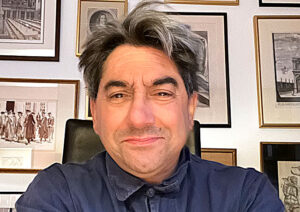Top Stories
Oxford Cardiologist Unveils Urgent Insights in New Heart Book

UPDATE: In a powerful new release, Professor Robin Choudhury, a renowned cardiologist at the University of Oxford, has launched his compelling book, The Beating Heart: The Art and Science of Our Most Vital Organ. Released this month during Irish Heart Month, the book explores the intricate relationship between human perception and scientific understanding of the heart over 2,500 years.
This urgent announcement sheds light on how the heart has been depicted across cultures and eras, blending art, religion, and science. Choudhury emphasizes the heart’s unique status, stating, “No other human organ has been so richly depicted over the years and across cultures.” He draws on historical and contemporary examples, including Leonardo da Vinci and modern street art, to illustrate our enduring fascination with this vital organ.
Experts are already praising the book. Asad Ahmad, presenter at BBC Radio London, calls it “fascinating,” while author Ross King describes it as “a remarkable exploration of how the human heart has been studied.”
In an exclusive interview, Choudhury explains his motivation, stating, “I have always had this conviction that the heart was the most important part.” His passion was sparked at age 14 during a biology class and further ignited by a book on medieval depictions of the heart. This led to a decade of research, culminating in a symposium at the Ashmolean Museum.
Choudhury’s insights extend beyond historical context; he addresses modern medical implications, including conditions like Takotsubo cardiomyopathy, often referred to as “broken heart syndrome.” He emphasizes the need for heart health awareness: “If we all treated our blood pressure, cholesterol, and diabetes risks, it would significantly impact heart disease.”
The interplay of emotion and science is a core theme in Choudhury’s work. He states, “The heart tells us how we feel… it’s a part of us, yet separate.” This duality is reflected in how people express passion or heartbreak, famously saying, “My heart isn’t in it” or even experiencing physical symptoms of emotional distress.
Choudhury’s book also delves into historical figures such as William Harvey, who revolutionized our understanding of blood circulation, and Christopher Wren, who contributed to early anatomical illustrations. These narratives connect the dots between past and present, illustrating how our understanding of the heart has evolved alongside cultural and scientific advancements.
Looking ahead, Choudhury is enthusiastic about future explorations. He notes, “We will still use the heart in our language. It’s fundamental to our experience of life.”
As readers dive into The Beating Heart, they will encounter rich illustrations and historical anecdotes that make the heart not just a biological organ, but a profound symbol of human experience. The book is available for £35 from Head of Zeus and online at bloomsbury.com.
This groundbreaking work is not just a book; it is a cultural detective trail that challenges us to reconsider what the heart means to us in the context of our lives. As the world observes Irish Heart Month, Choudhury’s call for heart health resonates louder than ever.
Stay tuned for more updates and expert insights as we uncover the latest developments in heart health and cultural significance.
-

 Top Stories2 months ago
Top Stories2 months agoTributes Surge for 9-Year-Old Leon Briody After Cancer Battle
-

 Entertainment3 months ago
Entertainment3 months agoAimee Osbourne Joins Family for Emotional Tribute to Ozzy
-

 Politics3 months ago
Politics3 months agoDanny Healy-Rae Considers Complaint After Altercation with Garda
-

 Top Stories3 months ago
Top Stories3 months agoIreland Enjoys Summer Heat as Hurricane Erin Approaches Atlantic
-

 World4 months ago
World4 months agoHawaii Commemorates 80 Years Since Hiroshima Bombing with Ceremony
-

 Top Stories2 months ago
Top Stories2 months agoNewcastle West Woman Patricia Foley Found Safe After Urgent Search
-

 Top Stories4 months ago
Top Stories4 months agoFianna Fáil TDs Urgently Consider Maire Geoghegan-Quinn for Presidency
-

 World4 months ago
World4 months agoGaza Aid Distribution Tragedy: 20 Killed Amid Ongoing Violence
-

 World4 months ago
World4 months agoCouple Convicted of Murdering Two-Year-Old Grandson in Wales
-

 Top Stories3 months ago
Top Stories3 months agoHike Donegal’s Errigal Mountain NOW for Unforgettable Summer Views
-

 World4 months ago
World4 months agoAristocrat Constance Marten and Partner Convicted of Infant Murder
-

 Top Stories3 months ago
Top Stories3 months agoClimbing Errigal: A Must-Do Summer Adventure in Donegal









